Now & New
- Eat
Oktoberfest in Hiroshima: Welcoming Autumn with Beer Festivals
Summer and autumn are two distinct seasons in Hiroshima, each with lovable and stereotypical traits that define the season better than the weather can. In Japan, summer is the season for fireworks, days at the beach, eating cold noodles, and imitation “Biergarten” events held in city centers. This is contrasted by autumn, which is the season for leaf viewing, hiking in the mountains, eating a wide array of mushrooms, and the start of no end to local festivals nationwide. Many would believe that autumn begins around September, but temperature-wise in Hiroshima, it feels like summer until mid- to late October, which means it’s hard to pinpoint exactly when the seasonal transition occurs. The Japanese phenomenon known as “Cool Biz” wherein working men in suits can remove their neckties and dress down to some extent also has a period variable by employer, with some saying Cool Biz lasts through the end of September and others saying that ties only come back on in November. This raises the question: is there a consistent occurrence in Japan that clearly draws a line between summer mode and autumn mode?
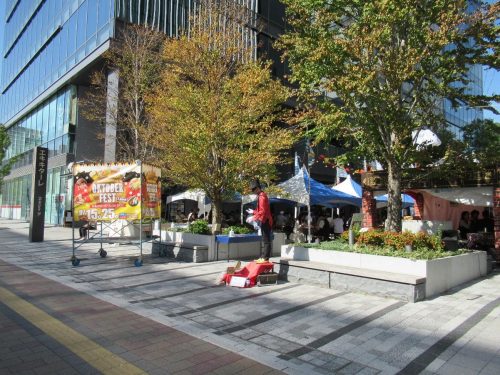
There may be a plethora of answers to the above question, but one of the first ideas that floats to the surface of my mind is Oktoberfest, a festival which is not Japanese in origin, but wholly embraced by Japanese people (at least the grown-ups) living in urban areas all over the country. It should go without saying that the Oktoberfest beer festival in Hiroshima is based off of the world-renowned Oktoberfest in Munich, Bavaria (Germany), which itself may have become more popular with non-Germans than it is with the locals there. I’ve attended the Hiroshima Oktoberfest in the past when it was held at the Old Hiroshima Citizens’ Baseball Stadium Ruins right by the Hiroshima Bus Center, but this year, the event was held at Ekikitare Street, a smaller plaza sandwiched between the Hiroshima TV building and the Granode building, all of which are a few paces northwest of the Hiroshima Station Shinkansen Exit. Although the aim is to market German beer to Hiroshimarians in combination with an inviting atmosphere, lively music, and foods that pair well with beer, I must be frank and declare that the beer brands and color scheme at the event site were the only remotely German things about Hiroshima’s Oktoberfest.
Oktoberfest Fairgrounds
If walking past the closed-off space in front of the convenience store with all the temporary benches and tables wasn’t enough of a hint, then head further west to find a human statue street performer and a big old sign with the colors of the German flag indicating that you have reached the Oktoberfest site. On a table by the entrance was that obligatory bottle of alcohol hand sanitizer as well as a laminated flyer encouraging guests to fill out a survey on their smartphones, with a free bottle of tea for the first 6,000 participants as an incentive. It’s actually a wise choice for a prize since the combination of beer and fried food tends to leave one extremely thirsty, so I decided to knock that out first and foremost to claim that tea.
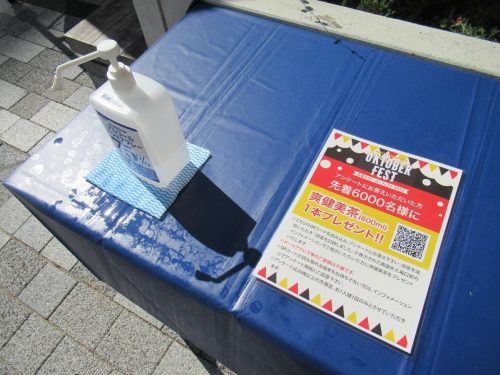
After claiming my bottle of tea, I began to really scope out the Oktoberfest grounds, which were humble and quite congested on account of the narrow space of Ekikitare Street. The event had a total of five stands, each selling a different brand of German beer, and surprise, surprise, none of them has been deemed an official Oktoberfest beer. Anyhow, the brands on tap this year were Ratsherrn, Gilde, Tucher, Weihenstephan, and Krombacher; I suppose I should be thankful that some of the beers are from Bavaria, and as the former two brand names were making their first appearance at this event, that was a bit of a treat as well. In between these five stands were customers coming and going past the stands, sitting at the tables, and having a grand time eating, drinking, talking, and listening to the stereotypical German music being played over the loudspeaker.

Although there are parasols for those who fear the intense sunlight, guests who wish to be completely out of the way of the elements can opt to sit and enjoy their food and beverages indoors. The ceiling was decorated with banners resembling the colors of the German flag, and thanks to a speaker inside the room, that same German music reached the customers in here as well. However, because the weather outside was so lovely and crowding indoors with everyone during a pandemic didn’t seem like the greatest idea, I knew I just had to nab a seat in fresh air.
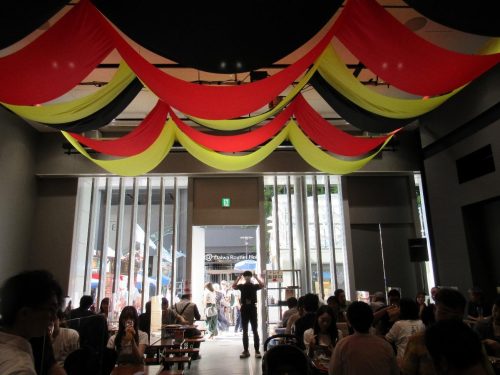
Essen und Trinken
In addition to serving different brands of beer, every stall also differed in its food selection. Bless their hearts, they tried so hard to imitate the traditional cooking of Germany, but when the signs advertising the food have spelling mistakes in both English and German, the authenticity factor is somewhat lost. When looking at the katakana, sometimes they are imitating the German name and sometimes the English name, but the translation ends up as something in between. What baffles me most about these mistakes is that they don’t seem to be the types of mistakes that an automatic translator would make, so I’m intensely curious as to who made these translations and if they bothered to show anybody else for proofreading. It’s gotten to the point that I tend to ignore English translations on all signs in Japan; it seems the Latin alphabet is less for informing foreigners and more for sign decoration, as anything written in English “looks cool” whether it’s correct or not.
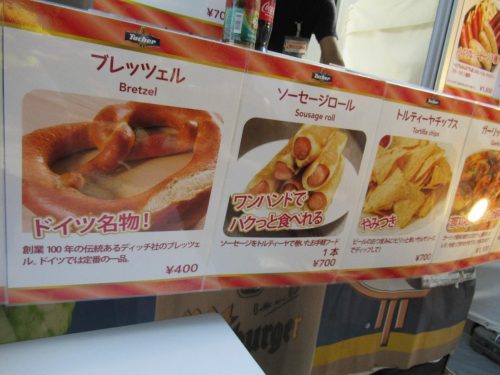
At every beer stand, there is an entire spectrum of flavors available, which is good for me, as I tend not to like the taste of beer. I was quite pleased with Tucher’s bill of fare, and decided to go for their Radler, a German classic that combines the goodness of lemonade with a not-so-bitter beer, kind of like an alcoholic Arnold Palmer. Had I possessed a fatter wallet and more days to visit the Oktoberfest here, I might have given the cassis and orange beers a go as well, but I only need one beer a day.
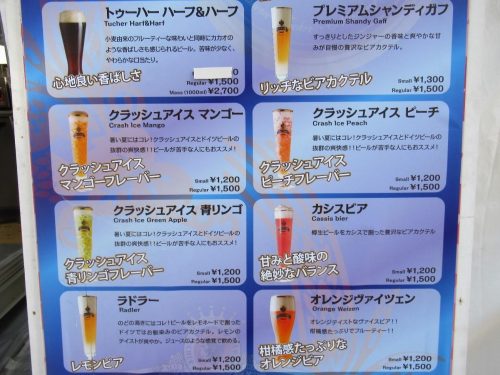
I was a bit indecisive on what food I wanted to pair with my Radler, as every item I saw was a pitiful imitation of the true deliciousness I experienced in Germany, and I had just returned from a vacation there. After aimlessly scanning the food menus of all the stands, I finally went with what were supposed to be Maultaschen (Swabian pasta pockets filled with ground meat in a clear broth), but were actually just cheese ravioli covered in a cream sauce. I took my meal—kindly served on a plastic tray that could also hold my beer—to a picnic table far from the ruckus and dug in.
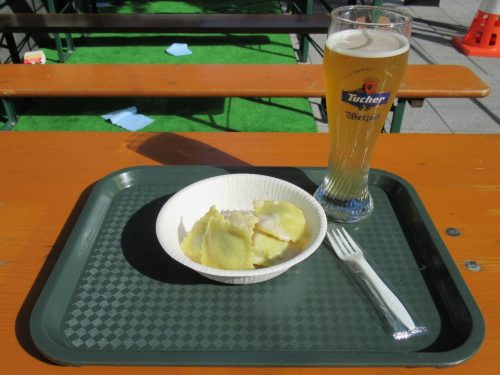
By the way, it should be noted that every beer stand charges a ¥1,000 deposit for a single beer glass, which can be refilled with subsequent beers over and over again. While everything else can be paid for with a credit card or electronic money, the deposit must be paid in cash (and will be returned in cash), so make sure to have multiple Hideyo Noguchis (¥1,000 banknotes) on your person, especially if you plan to try beers from multiple stands for comparison. I for one, though, instead needed more food to go with my single beer, and chose Tucher not just for their tasty Radler, but also for an additional incentive: yet another bottle of tea to take home upon returning my glass. Simply put, returning my beer glass properly (rather than taking it home) and filling out a survey detailing my experience at this event netted me three drinks for the price of one!
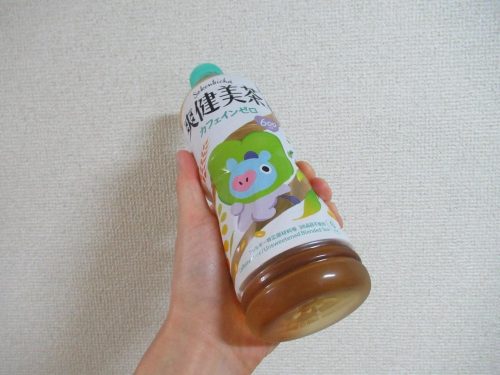
Moment of Joy: Snail’s Pace
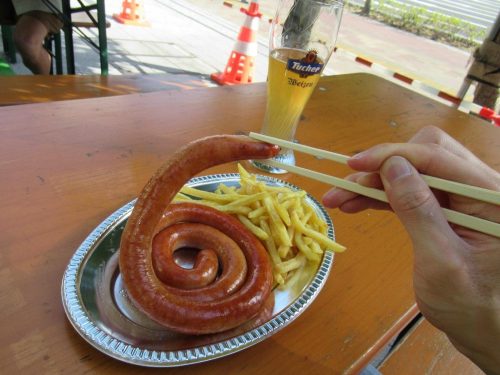
The second food item I bought was a smidgen more German in nature: “Bratwurstschnecke mit Pommes frites,” or “grilled sausage snail with French fries,” which unlike other foods for sale, was well worth my money and filled me up. This delicacy, which contains no snail flesh and is only shaped like a snail’s shell, was advertised as being 30 centimeters long, so I was able to munch on it at a leisurely pace (yes, with chopsticks; don’t judge me!) as I whittled away at my Radler. All the while, a refreshing breeze kept blowing my way, and it felt so good to just sit there right outside the convenience store with the wind on my face and passersby admiring our food and drink. Out of all the months of “Biergarten Season,” September has got to be the best for sipping on a beer outdoors.
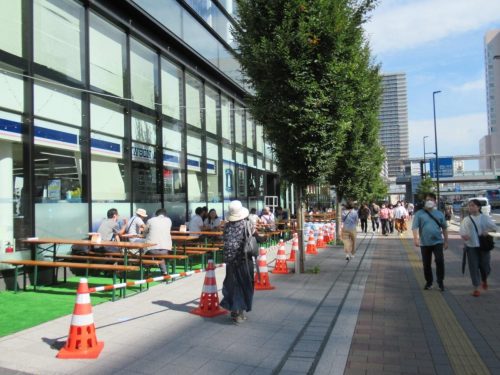
Rooftop Biergarten
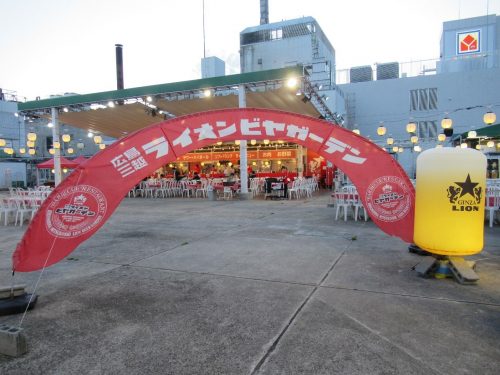
Another beer-related phenomenon that occurs in the summer is the department store rooftop Biergarten, which may be inspired by German events but is actually not a thing in Germany. In Hiroshima City, there are three department stores that open their rooftops to hungry and thirsty guests: Fukuya by Hiroshima Station, Mitsukoshi near Kaneyama-cho, and Sogo above the Hiroshima Bus Center. If you thought Hiroshima Oktoberfest was a letdown when it came to German-ness, these rooftop beer fests may feel like a new low, but if you ascend to these bars in the sky expecting Japanese beer culture, these places can clear pretty high hurdles. On this particular visit to the Mitsukoshi Biergarten, rather than go alone, I jumped at the opportunity to join a circle of friends for heightened enrichment.
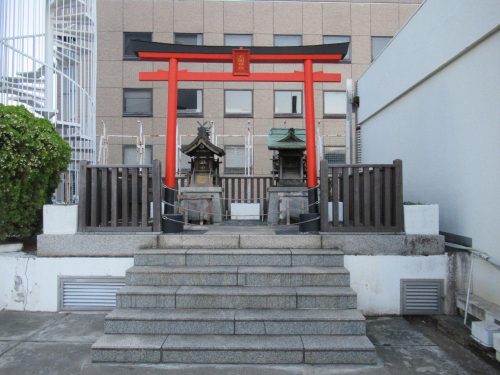
The first thing that may catch visitors’ eyes is the odd shrine located on the roof of the Mitsukoshi department store, of all places. Perhaps the purpose of “Misono Shrine” has something to do with alcohol consumption, but I’ve never seen a single soul pray here at any time I’ve been up here. In any case, after gawking at this spontaneous place of worship, customers will soon find themselves progressing to the admission counter, where they pay and are given a colored wristband corresponding to the course ordered. It was only this year that this Biergarten started selling multiple courses at different price tiers, which determine the type of food that gets served freshly at the table in addition to whatever is at the buffet (the past few years have made buffets a difficult product to offer in Japan), and of course, minors get a special rainbow wristband to remind employees not to serve them any alcohol.

The cheapest course here was a whopping ¥4,000 per person and came with ingredients for grilling “Genghis Khan,” a mutton and vegetable dish allegedly invented in Hokkaido. Refills on meat and veggies were allowed, and our wristbands granted us access to the buffet and one beer glass that could be filled and refilled with beer or soft drinks to one’s heart’s content, which meant the price tag could be thought of as expensive or cheap depending on how much one consumed. Quantity definitely trumps quality here, so to get the biggest bang for my buck, I immediately dashed to the bar to get my first beer. Unfortunately, they only had two brands of beer—Sapporo and Yebisu—but at least diners have the option to order a half-and-half for a twist on the usual.
With my beverage in hand, I was ready to proceed to the buffet area for some quick bites. The fried food section was in a separate section from the other stuff, and diners had to orally request whatever was inside the case; I got myself some chicken nuggets with a couple of deep-fried gyoza, then scooped my own curry, rice, and soup to take back to my table. There were bottles of hand sanitizer and vinyl gloves available so I didn’t have to worry too much about sanitation while I grabbed whatever I wanted. Salads, desserts, and other side orders were mostly placed in individual containers for optimal portioning, and were an inviting way to try every single item at the buffet. I ate so much food that my first beer was gone sooner than expected, and for my second beer onward I began requesting they fill my glass halfway so I could mix soda and other strange flavors into my drinks, just for kicks.
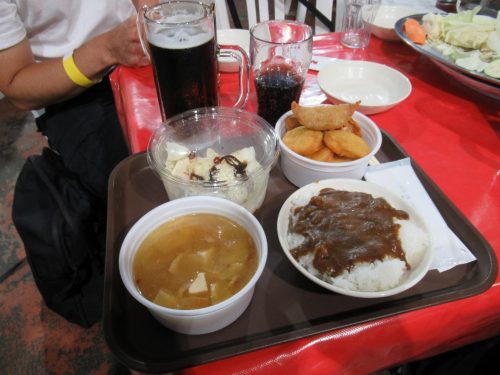
Kurzgesagt
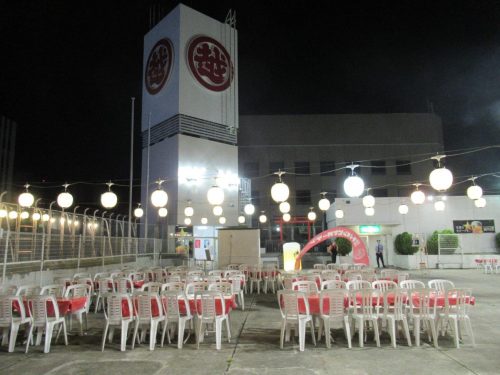
When all’s said and done, nobody in Hiroshima goes to any of the German-style beer festivals for German culture, but rather to gorge on festival food and possibly get drunk. Above all else, the camaraderie felt at these events is key to getting the most out of them, because so long as you’ve got good company, mediocre food goes down a lot faster. I for one was simply grateful for being able to attend these events once again during a time when parties were getting canceled left and right, and Oktoberfest was merely a prelude to the flurry of autumn festivals to come. If you’re here in Hiroshima at any point in the summer (especially in September), by all means, swing by one of these beer fests to experience authentic Japanese—not German—beer culture!
Written by the Joy in Hiroshima Team
